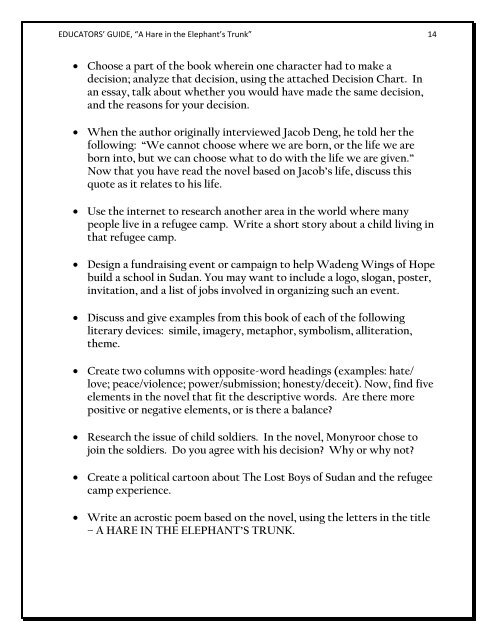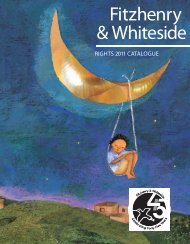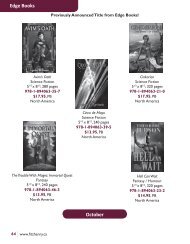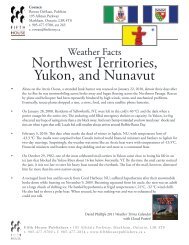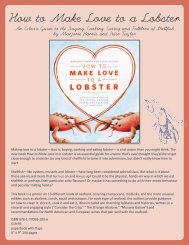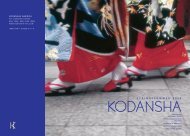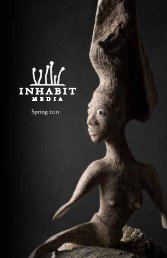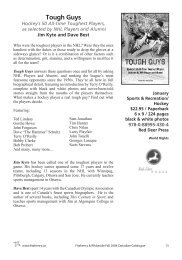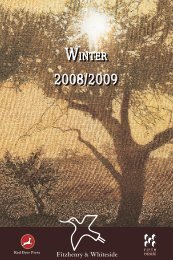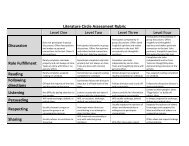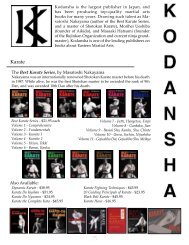EDUCATORS' GUIDE, “A Hare in the Elephant's Trunk”
EDUCATORS' GUIDE, “A Hare in the Elephant's Trunk”
EDUCATORS' GUIDE, “A Hare in the Elephant's Trunk”
You also want an ePaper? Increase the reach of your titles
YUMPU automatically turns print PDFs into web optimized ePapers that Google loves.
EDUCATORS’ <strong>GUIDE</strong>, <strong>“A</strong> <strong>Hare</strong> <strong>in</strong> <strong>the</strong> Elephant’s <strong>Trunk”</strong> 14<br />
• Choose a part of <strong>the</strong> book where<strong>in</strong> one character had to make a<br />
decision; analyze that decision, us<strong>in</strong>g <strong>the</strong> attached Decision Chart. In<br />
an essay, talk about whe<strong>the</strong>r you would have made <strong>the</strong> same decision,<br />
and <strong>the</strong> reasons for your decision.<br />
• When <strong>the</strong> author orig<strong>in</strong>ally <strong>in</strong>terviewed Jacob Deng, he told her <strong>the</strong><br />
follow<strong>in</strong>g: “We cannot choose where we are born, or <strong>the</strong> life we are<br />
born <strong>in</strong>to, but we can choose what to do with <strong>the</strong> life we are given.”<br />
Now that you have read <strong>the</strong> novel based on Jacob’s life, discuss this<br />
quote as it relates to his life.<br />
• Use <strong>the</strong> <strong>in</strong>ternet to research ano<strong>the</strong>r area <strong>in</strong> <strong>the</strong> world where many<br />
people live <strong>in</strong> a refugee camp. Write a short story about a child liv<strong>in</strong>g <strong>in</strong><br />
that refugee camp.<br />
• Design a fundrais<strong>in</strong>g event or campaign to help Wadeng W<strong>in</strong>gs of Hope<br />
build a school <strong>in</strong> Sudan. You may want to <strong>in</strong>clude a logo, slogan, poster,<br />
<strong>in</strong>vitation, and a list of jobs <strong>in</strong>volved <strong>in</strong> organiz<strong>in</strong>g such an event.<br />
• Discuss and give examples from this book of each of <strong>the</strong> follow<strong>in</strong>g<br />
literary devices: simile, imagery, metaphor, symbolism, alliteration,<br />
<strong>the</strong>me.<br />
• Create two columns with opposite-word head<strong>in</strong>gs (examples: hate/<br />
love; peace/violence; power/submission; honesty/deceit). Now, f<strong>in</strong>d five<br />
elements <strong>in</strong> <strong>the</strong> novel that fit <strong>the</strong> descriptive words. Are <strong>the</strong>re more<br />
positive or negative elements, or is <strong>the</strong>re a balance?<br />
• Research <strong>the</strong> issue of child soldiers. In <strong>the</strong> novel, Monyroor chose to<br />
jo<strong>in</strong> <strong>the</strong> soldiers. Do you agree with his decision? Why or why not?<br />
• Create a political cartoon about The Lost Boys of Sudan and <strong>the</strong> refugee<br />
camp experience.<br />
• Write an acrostic poem based on <strong>the</strong> novel, us<strong>in</strong>g <strong>the</strong> letters <strong>in</strong> <strong>the</strong> title<br />
– A HARE IN THE ELEPHANT’S TRUNK.


